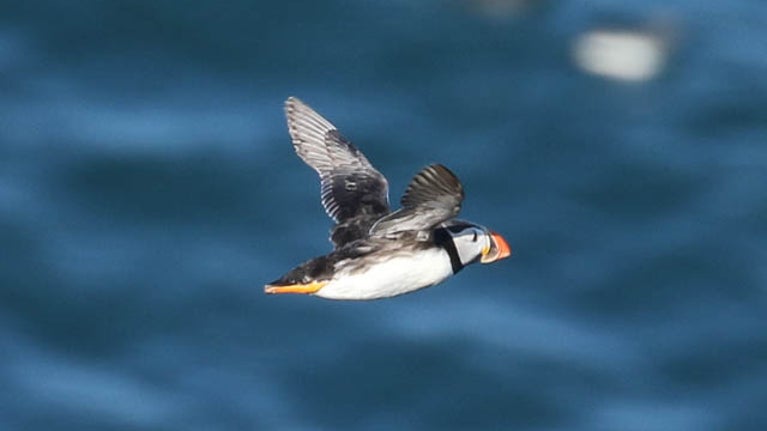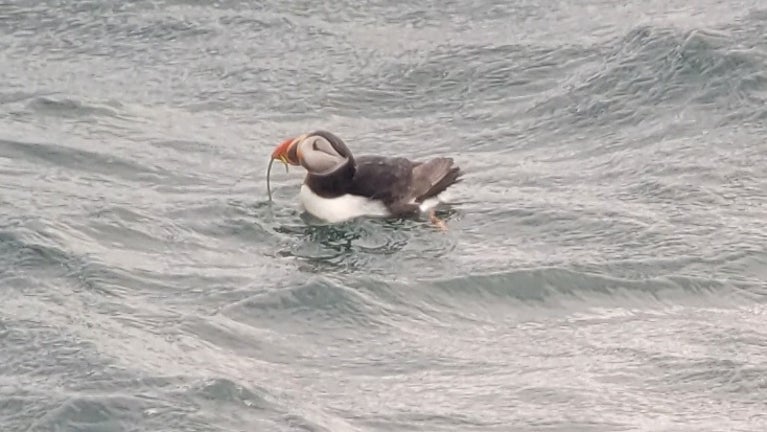Decline of puffin colony still perplexes
- Published:
- 03 April 2024
- Last updated:
- 08 April 2025

Despite extensive footage from remote cameras last year, the reason for the decline of the puffin colony near Dancing Ledge in Purbeck remains a mystery.
The cameras were installed at the start of the 2024 breeding season, in the narrow fissure on the cliff where the puffins nest. The hope was that footage would reveal why pufflings (chicks) aren’t surviving to fledge, with predation by rats or crows thought to be the most likely cause. Volunteers have since combed through over 70,000 photos – but no predators were captured on film.
The investigations have been led by marine ornithologist, Dr Richard Caldow, who been researching Purbeck’s puffin colony. His monitoring of the site, along with a team of volunteers, showed that in 2023, puffins carried fish to their nests for three weeks but then stopped abruptly. This suggests that the pufflings had died suddenly. In 2024, the puffins again began nest-building, but they weren't seen delivering any fish, probably because their eggs didn’t hatch.

Richard said: “It’s disappointing that the cameras didn’t reveal exactly what the problem is – because if they had, we could potentially take action to increase the puffins’ chances of rearing their young. This is important because it’s the last known regular nesting site for puffins on the mainland of southern England.
“Puffins were once abundant on this coastline – with some 85 birds recorded in Purbeck in 1958. In recent years, only three nesting pairs of puffins have been seen here, along with a few adolescent birds. For many years no fledglings have been spotted. Sadly, this severe decline means that without intervention, they are probably facing extinction here.”
There are now plans to reinstate the cameras next year, but with better equipment located exactly where each pair nests. These locations will be mapped following land-based monitoring by volunteers, as well as footage gathered by boat operators – the best views of the ledge are from the sea.
Ben Cooke, Rivers & Coast Project Officer for the National Trust said:
“Despite not giving a definitive answer, the cameras did give us useful information about what we need when we repeat the exercise, hopefully in 2026. Next time we can further refine the placement and quality of the camera equipment, optimising our chances of recording the puffins’ behaviour and the presence of any predators.
“It’s crucial to gather as much evidence as possible about what’s happening with the puffin colony, then we can assess if there is anything we can do to help. Along with our partner organisations, we’re committed to doing whatever we can to prevent the loss of this iconic, much-loved species.”

Although the cameras didn’t show any predators, they did reveal some fascinating facts about the puffins – and how they interacted with other sea birds.
- The number of photos showing one pair of puffins carrying nesting material in mid-April indicated that they laid an egg around that time, but it’s not known whether it hatched.
- The male and female puffins took turns to incubate the egg, with each shift being 10 to 20 hours but, unlike the razorbills, they never appeared together on camera.
- Puffins and razorbills were nesting very close together. The puffins seemed to avoid getting close to the much-bigger razorbills, which often threatened them when they did. The puffins often appeared at the ledge as soon as the razorbills left, so razorbills may be influencing the puffins’ nesting activity.
- Puffins are sometimes active at their nest site in total darkness, between 1am and 4am, but are most active between 5am and 8am.
The project has been a collaboration between Dr Richard Caldow, the National Trust and Dorset Wildlife Trust. Volunteers from the Purbeck Natural History Forum have played a vital role, not just in processing the images, but also doing land-based monitoring on a rota to record all puffin activity.
Dancing Ledge is a highly popular spot on the south Purbeck coastline, used by walkers, climbers and other activity groups. Because of the inaccessible location of the puffin nests, the easiest way to spot them is from the sea – there are guided boat trips run in the summer by Durlston Country Park and Birds of Poole Harbour.